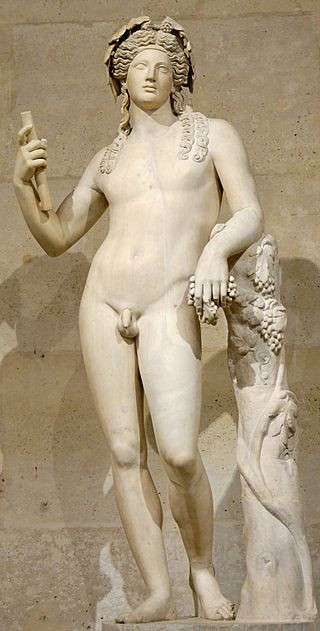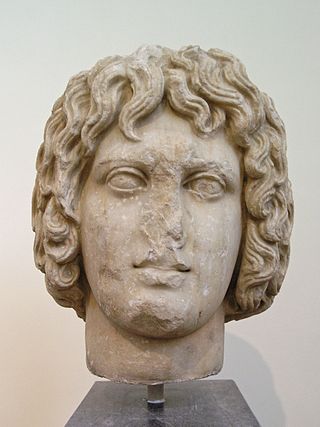
Ares is the Greek god of war and courage. He is one of the Twelve Olympians, and the son of Zeus and Hera. The Greeks were ambivalent towards him. He embodies the physical valor necessary for success in war but can also personify sheer brutality and bloodlust, in contrast to his sister Athena, whose martial functions include military strategy and generalship. An association with Ares endows places, objects, and other deities with a savage, dangerous, or militarized quality.

Hades, in the ancient Greek religion and mythology, is the god of the dead and the king of the underworld, with which his name became synonymous. Hades was the eldest son of Cronus and Rhea, although this also made him the last son to be regurgitated by his father. He and his brothers, Zeus and Poseidon, defeated their father's generation of gods, the Titans, and claimed joint rulership over the cosmos. Hades received the underworld, Zeus the sky, and Poseidon the sea, with the solid earth available to all three concurrently. In artistic depictions, Hades is typically portrayed holding a bident and wearing his helm with Cerberus, the three-headed guard-dog of the underworld, standing at his side.

In ancient Greek religion and myth, Dionysus is the god of wine-making, orchards and fruit, vegetation, fertility, festivity, insanity, ritual madness, religious ecstasy, and theatre. He was also known as Bacchus by the Greeks for a frenzy he is said to induce called baccheia. As Dionysus Eleutherius, his wine, music, and ecstatic dance free his followers from self-conscious fear and care, and subvert the oppressive restraints of the powerful. His thyrsus, a fennel-stem sceptre, sometimes wound with ivy and dripping with honey, is both a beneficent wand and a weapon used to destroy those who oppose his cult and the freedoms he represents. Those who partake of his mysteries are believed to become possessed and empowered by the god himself.
In ancient Greek religion and mythology, Zagreus was a god sometimes identified with an Orphic Dionysus, a son of Zeus and Persephone, who was dismembered by the Titans and reborn. In the earliest mention of Zagreus, he is paired with Gaia and called the "highest" god, though perhaps only in reference to the gods of the underworld. Aeschylus, however, links Zagreus with Hades, possibly as Hades' son, or as Hades himself. Noting "Hades' identity as Zeus' katachthonios alter ego", Timothy Gantz postulated that Zagreus, originally the son of Hades and Persephone, later merged with the Orphic Dionysus, the son of Zeus and Persephone.
In ancient Greek religion and mythology, Iacchus was a minor deity, of some cultic importance, particularly at Athens and Eleusis in connection with the Eleusinian mysteries, but without any significant mythology. He perhaps originated as the personification of the ritual exclamation Iacche! cried out during the Eleusinian procession from Athens to Eleusis. He was often identified with Dionysus, perhaps because of the resemblance of the names Iacchus and Bacchus, another name for Dionysus. By various accounts he was a son of Demeter, or a son of Persephone, identical with Dionysus Zagreus, or a son of Dionysus.
The Oxford Classical Dictionary (OCD) is generally considered "the best one-volume dictionary on antiquity," an encyclopædic work in English consisting of articles relating to classical antiquity and its civilizations. It was first published in 1949, edited by Max Cary with the assistance of H. J. Rose, H. P. Harvey, and Alexander Souter. A second edition followed in 1970 (OCD2), edited by Nicholas G. L. Hammond and H. H. Scullard, and a third edition in 1996 (OCD3), edited by Simon Hornblower and Antony Spawforth. A revised third edition was released in 2003, which is nearly identical to the previous third edition. A fourth edition was published in 2012 (OCD4), edited by Simon Hornblower, Antony Spawforth, and Esther Eidinow. In 2016, a fully digital edition launched online, edited by Sander Goldberg (2013–2017) and Tim Whitmarsh (2018–present). Continuously updated on a monthly basis, this edition incorporates all 6,300 entries from OCD4 as well as newly commissioned entries, and features multimedia content and freely accessible maps of the ancient world.

Religious practices in ancient Greece encompassed a collection of beliefs, rituals, and mythology, in the form of both popular public religion and cult practices. The application of the modern concept of "religion" to ancient cultures has been questioned as anachronistic. The ancient Greeks did not have a word for 'religion' in the modern sense. Likewise, no Greek writer known to us classifies either the gods or the cult practices into separate 'religions'. Instead, for example, Herodotus speaks of the Hellenes as having "common shrines of the gods and sacrifices, and the same kinds of customs."

Mount Nemrut or Nemrud is a 2,134-metre-high (7,001 ft) mountain in southeastern Turkey, notable for the summit where a number of large statues are erected around what is assumed to be a royal tomb from the 1st century BC. It is one of the highest peaks in the east of the Taurus Mountains.

The word chthonic, or chthonian, is derived from the Ancient Greek word χθών, "khthon", meaning earth or soil. It translates more directly from χθόνιος or "in, under, or beneath the earth" which can be differentiated from Γῆ, or "ge", which speaks to the living surface of land on the earth. In Greek, chthonic is a descriptive word for things relating to the underworld and can be used in the context of chthonic gods, chthonic rituals, chthonic cults, and more. This is as compared to the more commonly referred-to Olympic gods and their associated rites and cults. Olympic gods are understood to reference that which exists above the earth, particularly in the sky. Gods that are related to agriculture are also considered to have chthonic associations as planting and growing take place in part under the earth.

Agathos Daimon originally was a lesser deity (daemon) of classical ancient Greek religion and Graeco-Egyptian religion. In his original Greek form, he served as a household god, to whom, along with Zeus Soter, libations were made after a meal. In later (post-)Ptolemaic antiquity he took on two partially distinct roles; one as the Agathos Daimon a prominent serpentine civic god, who served as the special protector of Alexandria. The other as a genus of serpentine household gods, the Agathoi Daimones, individual protectors of the homes in which they were worshipped.

Orphism is the name given to a set of religious beliefs and practices originating in Thrace and later spreading to the ancient Greek and Hellenistic world, associated with literature ascribed to the mythical Thracian poet Orpheus, who descended into the Greek underworld and returned. This type of journey is called a katabasis and is the basis of several hero worships and journeys. Orphics revered Dionysus and Persephone. Orphism has been described as a reform of the earlier Dionysian religion, involving a re-interpretation or re-reading of the myth of Dionysus and a re-ordering of Hesiod's Theogony, based in part on pre-Socratic philosophy.

Interpretatio graeca, or "interpretation by means of Greek [models]", refers to the tendency of the ancient Greeks to identify foreign deities with their own gods. It is a discourse used to interpret or attempt to understand the mythology and religion of other cultures; a comparative methodology using ancient Greek religious concepts and practices, deities, and myths, equivalencies, and shared characteristics.
Pyanopsia (Πυανόψια) or Pyanepsia (Πυανέψια) was an ancient Athenian festival held in honor of Apollo in Athens on the 7th day of the month Pyanepsion (October/November). Its name literally means "bean-stewing", in reference to one of the sacred offerings given during this time, and is taken from the Greek words πύανος - pyanos "bean" and ἕψειν - hepsein "to boil".
Pamphilus of Amphipolis was a Macedonian painter and head of Sicyonian school. Under his influence painting became a regular part of Greek classical education, and a number of his pupils went on to become well-known painters.

In ancient Greek religion and myth, Eubuleus is a god known primarily from devotional inscriptions for mystery religions. The name appears several times in the corpus of the so-called Orphic gold tablets spelled variously, with forms including Euboulos, Eubouleos and Eubolos. It may be an epithet of the central Orphic god, Dionysus or Zagreus, or of Zeus in an unusual association with the Eleusinian Mysteries. Scholars of the late 20th and early 21st centuries have begun to consider Eubuleus independently as "a major god" of the mysteries, based on his prominence in the inscriptional evidence. His depiction in art as a torchbearer suggests that his role was to lead the way back from the Underworld.

Voces magicae or voces mysticae are pronounceable but incomprehensible magical formulas that occur in spells, charms, curses, and amulets from Classical Antiquity, including Ancient Greece, Egypt, and Rome.
Esther Eidinow is a British ancient historian and academic. She specialises in ancient Greece, particularly ancient Greek religion and magic. She has been Professor of Ancient History at the University of Bristol since 2017.

Lygdamis, who ruled c. 520–484 BCE, was the first tyrant of Caria under the Achaemenid Empire. He was of Carian-Greek ethnicity. He was the father of Artemisia I of Caria.

The Siege of Mantinea occurred in 385 BC, and resulted in a victory of the Spartans over the city of Mantinea, which was defeated and dismembered. On this occasion, Epaminondas, then fighting on the side of the Spartans, famously rescued his fellow Theban Pelopidas.
Euthydemus of Chios also Euthydemos was a Greek sophist born in Chios, who emigrated with his brother Dionysodorus to Thurii in Italy. When exiled from this city, he went to Athens where he lived for many years. Euthydemus was an older contemporary of Socrates. Plato depicts him and his brother in the Euthydemus dialogue, and he is further referenced by Aristotle.













